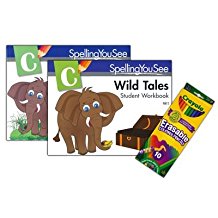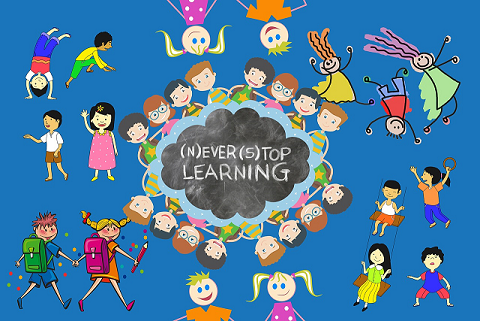Spelling You See Curriculum Review
- “This post contains affiliate links, which means I receive a small commission, at no extra cost to you, if you make a purchase using any links on this page.”
I was always a good speller. On Mondays my teacher would give us a pretest with the spelling list for the week. If I got 100% on the pretest, then I didn’t need to take the Friday test. I see words in my head and intuitively know how to spell them. Rarely did I need to take the Friday test. As a result, it is so hard for me to understand why my children can’t spell as easily as I can.

Throughout my years as a first and second grade teacher, I watched as time after time so many students would get most or all of the words correct on their spelling test, only to find the words misspelled on their next writing assignment. When I started to homeschool my kids, I wanted to find something different.
I discovered Spelling You See at my local homeschool conference and was intrigued. Spelling You See doesn’t use word lists or spelling tests. It is a research based program which brings each child through the developmental stages of spelling. The program starts with phonics but goes beyond, because we all know that for as many words that follow the English grammar rules, there are quite a few that don’t. It starts using with using basic letter patterns and builds on that using visual memory and continual practice and review.
These are the five developmental stages of spelling:
-
Preliterate
In this stage, the child begins to understand the basic concepts of language. Books are read from left to right, and from the top to the bottom. The child may start “pretend writing” using scribbles to stand for language. Soon they may start writing letters or letter like symbols in strings to represent words. These things build the foundation for literacy and lead to the next stage.
-
Phonetic
The phonetic stage occurs when the child starts to make connections between spoken and written language. They begin to distinguish the different sounds that our language makes and understand that the letters represent those individual sounds. At this stage the child starts to use invented spelling. This spelling shows sound to letter correspondence. The child is ready to move onto the next stage of skill development when they have learned the basic phonics rules and can apply them consistently to reading and spelling.
-
Skill Development
This stage is the most difficult and takes the longest to progress through. Once the basic phonics rules are learned, then the child can apply them to his spelling. However, because there are as many exceptions to the rules as there are rules, it creates confusion in learning how to spell. At this stage, the phonics rules are de-emphasized and visual memory applied in context becomes the process in which spelling is learned. The child learns new spelling patterns that are consistently practiced over and over again in the context of interesting literature. This stage usually lasts through the late elementary years.
-
Word Extension
This stage builds on the previous one but breaks up the words into smaller pieces, syllables. It deals with prefixes and endings, and the reasons why we double consonants before an ending, drop vowels before endings, and shorten words when we make prefixes. The child usually reaches this stage during the later elementary or middle school years.
-
Derivational Constancy
This stage explores the roots of words and the patterns of words that have similar origins. The individual begins to understand how the spelling patterns and word meanings are related. The best progress through this stage can occur if there is a strong foundation in the first four stages.
Because these stages are not attached to distinct grade levels, the Spelling You See curriculum is not attached to grade levels either. You may ask, “How do I know which stage my child is in, or what level should I start my child at?” The level at which a child should start is based on their reading level. According to Spelling You See guidelines, their purpose is to start a child at one level below their reading level to encourage visual memory or correct spellings instead of struggling with challenging passages. This link will bring you to the placement page on their website. It is very important that you determine your child’s level correctly before you buy the curriculum.
The Spelling You See curriculum progresses through seven courses or levels.
Level A – Listen and Write
In this level, the book focuses on letter formation and short vowel sounds. At the beginning of the book the student is asked to trace and write the letters and write the words that the teacher says. As the lessons progress, they consist of the student writing the words that she hears. Each lesson is one page long and should take 10 minutes or less. The words increase in difficulty from three letter words to five letters. By the end of the book the student is writing five letter words and has been introduced to digraphs such as -ck, ch, th, and consonant blends.
Level B – Jack and Jill
This is one of my favorite levels so far. Each lesson contains two pages now, so there are now two books, Part 1 and Part 2.
In Part 1, the book introduces the student to one nursery rhyme per week. The parent and student read the passage together each day. Then the student must find one or two literary objects such as rhyming words, capital letters, punctuation, and opposites in that week’s nursery rhyme. Then he copies the words in the rhyme and writes the words that his teacher says.
In Part 2, the student is introduced to chunking, in which the student identifies letter patterns. It starts out with vowel chunks, and later on adds bossy r chunks, consonant chunks, endings, and tricky y guy. The student marks all of the chunks required in the week’s nursery rhyme, and on the opposite page copies the rhyme. On day four of each week, the student chunks the passage and then has a “no rule day” in which she can draw a picture or write her own story. This day is my kids’ favorite. On the fifth day, the student chunks the passage and then completes dictation.
During dictation the teacher(parent) reads the rhyme to the student and he writes what he hears. Dictation should last for no longer than ten minutes, and unlike spelling tests, you are allowed to help your child. Their philosophy says that it is better to have help spelling it correctly and see it correct than to write and see it incorrectly. You can evaluate your student’s progress over time as their speed and accuracy should increase.
Level C – Wild Tales
In the first few lessons of this level, the student starts with nursery rhymes just like Jack and Jill but then progresses to 5 or 6 sentence non-fiction passages of different animals and sea creatures. Each week follows the same pattern. The student chunks the passage each day and copies it for the first three days. On the fourth day the student has a “no rule” day and on the fifth dictation.
Level D – Americana
Americana features the same spelling routine as the previous levels with chunking each day, copywork, no rule day and dictation. The passages that the student reads and spells are non-fiction passages about American life and culture. As with the previous two levels it contains two books, and the reading level gradually increases as the student works through it.
With this level dictation takes place on days four and five. On day four the passage is dictated and the teacher(parent) can help when needed. On day five, dictation again with only help for punctuation and capitalization. Even at this level, dictation should only take 10 minutes, even if the student does not finish the passage.
Level E – American Spirit
American Spirit highlights people and events from American history. It includes the same daily process as Americana while the reading level of each passage gradually increases.
Level F – Ancient Achievement
Ancient Achievement begins the transition from the Skill Development stage to the Word Extension stage. In this stage instead of the parent reading to the student, the student reads the passage to the parent. Chunking is done each day, copywork on days one through three, and dictation on days 4 and 5. An addition to this level is the spotlight within each weekly lesson. The spotlight highlights a word pattern or its components to increase interest on the part of the student and for pattern recognition.
Level G – Modern Milestones
Modern Milestones applies to the Word Extension stage of spelling. It focuses on people who have achieved influence in our world in recent history. This level stresses prefixes and suffixes and how they change the spelling of words. Each lesson explains how the particular prefixes and/or suffixes work, and the student is required to underline them. Copywork is completed the first two days of the week. On day 3, a workshop page in which the student practices with the prefix and suffix patterns for the week. On days 4 and 5, dictation as in previous levels.
What I Like about Spelling You See
Spelling You See’s unique approach to spelling allows each child to learn how to spell developmentally. I love the constant review that each level provides. But at the same time, the work gets a little more challenging. It emphasizes the correct spellings and success without focusing on the mistakes. The student has a chance to learn a little history along with copywork and grammar. The spelling is done in a relevant context instead of just lists of words. I love the fact that spelling only takes ten minutes to do each day, but my children still learn. Because of the chunking, copywork, and dictation activities, Spelling You See is an exciting option for students to learn how to spell.
Also, check out my post on the Math U See Curriculum as well.














